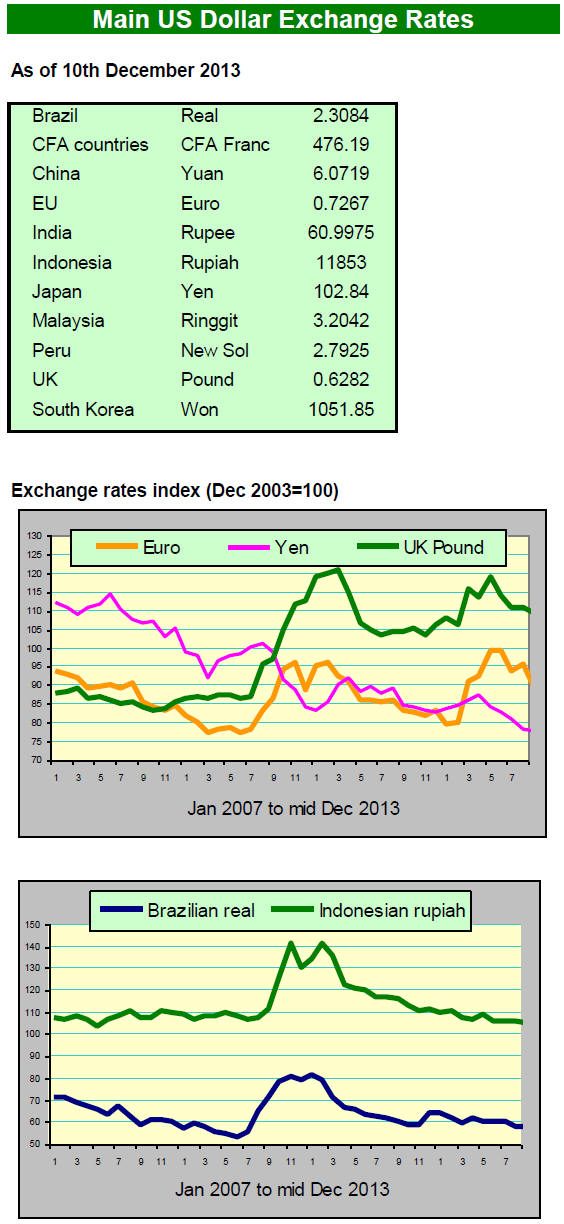2. GHANA
Import duty relief for mills importing
logs
The Forestry Commission is consulting with the Customs
Divisions of the Ghana Revenue Authority to try and
secure tax exemptions for those timber companies which
wish to import log raw materials.
Ghana intends to step up imports of timber raw materials
from Cameroon and elsewhere to bridge the gap between
demand from the established timber mills and the
domestic supply of raw materials.
Domestic demand for wood products is high and expected
to grow further as the population expands and as incomes
rise. The main source of demand is from the housing and
construction sectors.
The import option is considered a short to medium-term
measures to ensure the domestic timber enterprises remain
viable and continue to contribute to economic growth and
job security.
Africantimber.net launched to spur intra-African
trade
In spite of its vast timber resources, Africa is a net
importer of timber and wood products but the intra-
African trade in timber is less than 10% of all imports.
The lack of market information and transparency,
constraints related to policy and legal frameworks,
logistics and infrastructures as well as limited managerial
capacity in the private sector are the main causes for the
weak intra-African trade.
This was the conclusion of a study ¨DGood Neighbour ¨C
Promoting Intra-African Markets in Timber and Timber
Products¡¬ produced by the International Tropical Timber
Organization (ITTO).To try and stimulate greater intra-
African trade an online business-to-business timber
marketplace (Africantimber.net) has been launched to
provide market information and facilitate communication
among traders in the region.
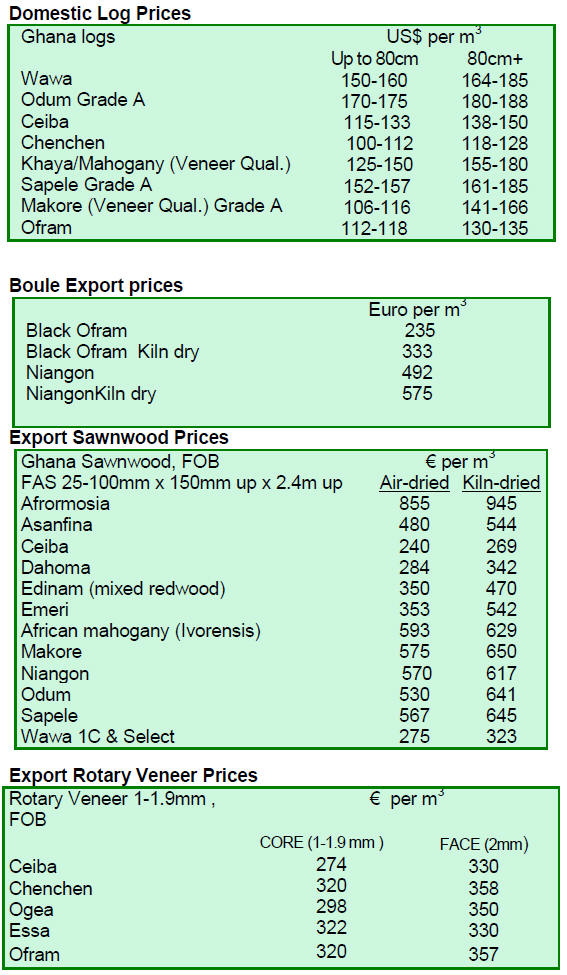
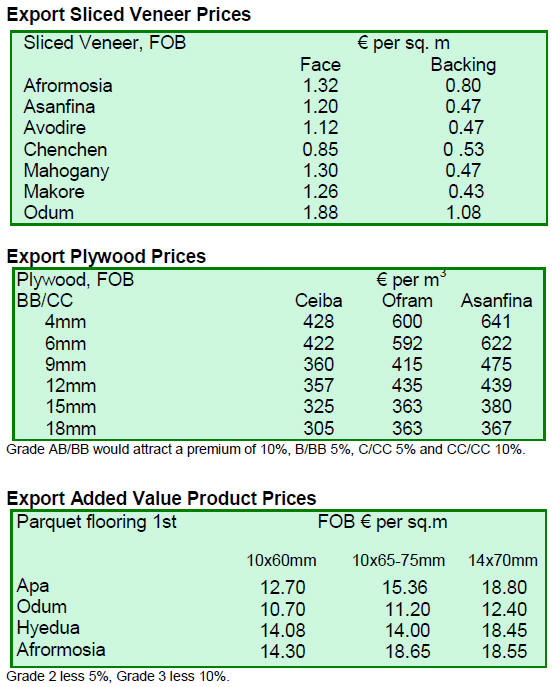
3. MALAYSIA
Certification seen as key to improved
market share
A newly formed Timber Industry Forum (TIF),
comprising associations representing the sawntimber,
plywood and furniture sectors as well as timber traders
signed a memorandum of understanding (MOU) with the
Forest Research Institute of Malaysia (FRIM) to enhance
product quality for better marketability.
It is expected that work proposed in the MOU will focus
on certification of timber products for local and
international markets. The work on certification will focus
on compliance with domestic and international technical
requirements.
The industry and trade participants of the TIF are
optimistic that, with the technical help of FRIM,
Malaysian timber products will secure a larger slice of the
international markets as well improved sales in domestic
markets.
Industry and government consultation
The Ministry of Plantation Industries and Commodities
recently consulted with various industry sectors to obtain
their input on current issues of concern. The consultation
was a platform for the industry to bring up problems for
the attention of related government agencies, councils and
related institutions.
The two day event was divided into various sessions such
as palm and biofuel, rubber, timber and cocoa, pepper,
tobacco, kenaf and sago.
The timber industries raised seven main issues on
which
they have concerns: delivery systems, rules and policies,
labour availability, the government minimum wages, raw
material supply as well as incentives and finance. Among
the major concerns of the timber industry are the variable
definitions and standards on legality in importing
countries.
Sabah and EU to work on reducing forest degradation
and deforestation
The European Union (EU) and Sabah Forestry Department
have launched a RM16 million (US$4.9 million)
programme of work on tackling climate change through
sustainable forest management and community
development. The four year programme is aimed at
contributing to sustainable and low carbon development in
the state of Sabah.
Both parties will cooperate on a REDD+ strategy to reduce
emissions from deforestation and forest degradation,
promote the sustainable management of forests as well as
the conservation and enhancement of forest carbon stocks.
The programme has been designed to support Sabah¡®s
efforts to reduce greenhouse gas emissions from forest
degradation and deforestation. In this sense, the director of
Forestry Department, Sam Mannan, said: ¨DIt (the joint
Sabah:EU programme) will help us to effectively engage
local communities in forest management and rehabilitation
both on government and community lands. I believe that
this will generate valuable experiences and enhance our
capacity to further develop and implement the planned
Sabah REDD+ strategy¡¬.
The Borneo Post newspaper reported Mannan as adding
¨Dthe programme would benefit the poorest people in Sabah
¨C those who are dependent on the forest for their
livelihood. Through this programme, they will appreciate
the environment better, not that they don¡®t already, but we
want to prove that by conserving the forest and by
sustainable management on the ground, this would also
improve their livelihood. There is no point having
conservation and what not at the expense of the people¡®s
livelihood and people¡®s standard of living. This must be
addressed. This is part of the objectives and goals.¡¬
Good prospects in Japanese and Korean markets
In plywood exporters in Sarawak are upbeat that recent
market developments are very positive and are driving up
demand for panel products in two key markets, Japan and
South Korea.
Japan seems set to increase imports of plywood from
Sarawak, partly attributed to Japan hosting the Olympic
Games in 2020. South Korea is also set to increase imports
of plywood when the three-year anti-dumping duties on
Malaysian plywood expire at end of February 2014.
Japanese companies operating in Sarawak held a closed
door meeting last month to analyse various matters
including the capacity of plywood supply from Sarawak.
It is widely thought that they are preparing to import more
plywood for the many projects of the 2020 Olympics
Games.
Sarawak Timber Industry Development Corporation
(STIDC) figures reveal that plywood exports from
Sarawak to South Korea recovered sharply to 331,457
cu.m last year from 239,449 cu m in 2011 when the antidumping
duties came into force.
In 2010, some 512,000 cu m was exported to South Korea.
Sarawak plywood exports to South Korea are likely to
benefit from reported anti-dumping duties ranging from
2.4% to 27% being imposed on plywood from China.
Latest log prices
Log traders based in Sarawak reported FOB export prices
as follows:
Meranti SQ US$ 255 ¨C 275 per cu.m
Kapur SQ US$ 320 ¨C 345 per cu.m
Keruing SQ US$ 290 ¨C 325 per cu.m
Selangan batu regular US$ 505 ¨C 525 per cu.m
4. INDONESIA
2014 Growth projections
The Indonesian National Economic Committee (Komite
Ekonomi Nasional, KEN) is forecasting that Indonesia¡®s
GDP growth will slip to 5.5 percent next year, down from
the 5.7 percent growth rate estimated for this year. KEN
chairman, Chairul Tanjung, has said the Indonesian
economy in 2014 would not be very different from the
trend seen towards the end of 2013.
Improved household consumption
A consumer survey by the Bank of Indonesia (BoI) in
November has indicated that household consumption
improved slightly and this was reflected on the Consumer
Confidence Index (CCI) which increased by almost 5
points to 114.3. The improved CCI is, says the BoI, the
result of improving economic conditions and a healthier
job market.
Looking ahead the survey suggests consumers are
optimistic about short term economic prospects. Over the
next three months the indications in the survey are that
consumer prices will continue to edge up especially for
food, beverages and tobacco products. Next year is
election year in Indonesia so efforts may be made to hold
down price increases on basics.
Faltering rupiah
Indonesia's central bank governor is urging the private
sector to sell dollars to help the efforts of the bank
maintain stability in the dollar:rupiah exchange rate. The
rupiah/dollar exchange rate dropped below 12,000 recently
but has since recovered some ground.
However international currency traders are bearish
on the
rupiah as demand in Indonesia for dollars increases at year
end.
SVLK audit process too tough for small enterprise
A staff member of the Indonesia Multi Stakehoder
Forestry Programme (MSFP) has said that many small
businesses are facing fundamental problems that prevent
them from satisfying an audit to obtain the government¡®s
timber legality verification system (SVLK) certificate.
Speaking during a discussion held by the International
Centre for Trade and Sustainable Development (ICTSD)
and the Center for International Forestry Research
(CIFOR), Agus P. Djailani, of the MSFP said ¨Dto qualify
for an SVLK audit companies must posses various legal
business permits, however small companies find this very
costly and complicated, ,¡¬
Available data show that, for instance, each SME may
require more than Rp 17 million (US$1,420) to acquire the
necessary environment-related business documents.
In addition, the SVLK audit process costs between Rp 24
million and Rp 30 million per enterprise and is valid for
only three to six years.
According to CIFOR, there are 4,000 registered timber
exporters as of now. However, there are still tens of
thousands of unregistered small timber businesses.
CIFOR forest governance scientist Krystof Obidzinski
said it would take more time, money and capacity building
to assist small businesses in preparing themselves to
undergo the SVLK audit.
In response the Forestry Ministry Director of Forestry
Development, Agus Sarsito, said that inter-ministry
coordination ¡ª between the Forestry, Trade and the
Cooperatives and Small and Medium Enterprises
ministries ¡ª was important for solving the problem.
Trade Ministry Director, Oke Nurwan, argued that the
main problem is the lack of awareness of export trends and
of the SVLK amongst small entrepreneurs. He said, ¨Dthey
(SMEs) see the SVLK audit as an obstacle, though such
certification is getting more and more necessary in the
global market,¡¬
Indonesia and Sweden cooperate on renewable energy
The development of a renewable energy policy by the
Indonesian government is being assisted by the
Indonesian-Swedish Initiative for Sustainable Energy
Solutions (INSISTS).
The Swedish Ambassador to Indonesia, Ewa Polano, is
reported in the Jakarta Post as saying ¨DIndonesia and
Sweden are two countries that have high ambitions to
reduce carbon emissions and, therefore, it is really
important to focus on renewable energy.¡¬
The Indonesian National Energy Council (DEN) and the
Swedish Energy Agency (SEA) have concluded an
agreement for the establishment of a research department
within the Gadjah Mada University.
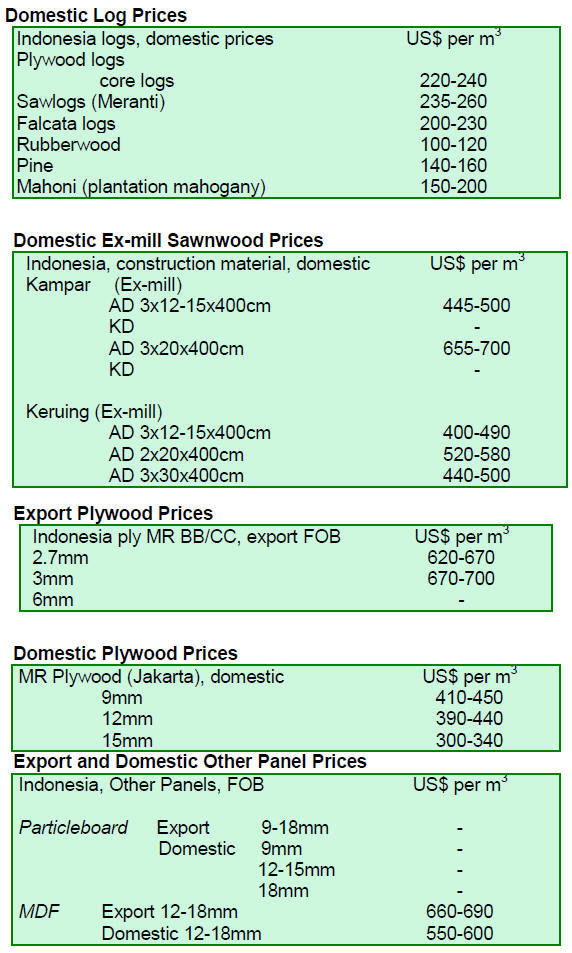
¡¡
5. MYANMAR
Teak logs sales for the local wood
industry
A total of 430 tons of Sawing Grade 7 teak logs were sold
to domestic mills by open tender on 6 December. Three
local companies bid during the sale. The highest bid
obtained was US$610 per ton, considerably lower than the
price that MTE can secure from international buyers for
logs of the same grade.
Despite the significant difference in log grading for local
sales and international tenders analysts point out that the
price of just US$610 per ton is an indication of what price
levels the MTE can expect to get from the sales of logs
after the log export ban.
A lack of foreign competition will invariably bring log
prices down resulting in much reduced revenue for the
MTE but better incentives for domestic manufacturers.
Market Situation
In November 37, 900 cubic metres of teak logs and
115,720 cubic metres of other hardwood logs were
shipped. This brings the total volume shipped from April
to the end of November to approximately 279,000 cubic
metres teak logs and 975,900 cubic metres of other
hardwood logs.
Analysts say markets remain mixed with weak demand for
non-teak hardwood logs. Analysts expect export shipments
to increase in the coming three months in advance of the
log export ban set for 1 April 2014.
Myanmar Forest Industry gets International support
The Building and Wood Workers International (BWI) in
collaboration with the Ministry of Environmental
Conservation and Forestry (MOECAF) and the Ministry of
Labour, Employment and Social Welfare organised a
Conference in Yangon from 28 to 29 November 2013 on
Sustainable Forest Management (SFM) in Myanmar.
The BWI is a Global Union Federation grouping free and
democratic unions with members in the Building, Building
Materials, Wood, Forestry and Allied sectors. The BWI
has 334 trade unions representing around 12 million
members across 131 countries around the world.
Ambet Yuson, General Secretary of the Building and
Wood Workers International (BWI) said ¨Dsustainably
managed forests that promote social justice, environmental
protection and enhanced economic output have the
potential to reduce poverty, spur economic development,
create jobs and contribute to a healthy local and global
environment¡¬.
MOECAF Minister Win Tun delivered a keynote address
welcoming the conference saying the conference brought
together global experience and learning to foster
cooperation with international bodies and experts enabling
Myanmar to promote SFM practices.
The Myanmar Timber Merchant¡®s Association Joint
General Secretary, Barber Cho, urged the International
Labour Organisation (ILO) to support capacity building
and training for employers¡® organisations in the country.
Maung Maung ,General Secretary of the Federation of
Trade Unions of Myanmar, spoke at length on the
opportunity for developing a "decent work agenda" for
workers in the Myanmar¡®s Wood and Forestry sector.
Asia Pacific BWI Vice President Rama Chandra Khuntia
gave a closing address noting that the evolving process of
sustainable forest management in Myanmar was reflective
of the changed national circumstances and was in
compliance with internationally accepted standards.
The Myanmar Government, last year enacted the
Environmental Conservation Law as its response to save
jobs and promote sustainable development.
Foreign Investment in the wood sector
The Myanmar Investment Commission (MIC) has
approved the 100% investment of an Indian company
MAK Plywood Industries Pvt. Ltd. for the production of
plywood and veneer in Myanmar.
The MIC also reported a joint venture by BS Progressive
Pvt. Ltd, of India and the National Export Import
Company of Myanmar for the production of plywood and
veneer.
Myanmar posts US$1 .1 billion trade deficit
Myanmar Central Statistical Organisation reported a trade
deficit of over US$1 billion during the first half of FY
2013-14.
Export earnings were US$4497.54 mil. and income from
the overland border trade was US$1771.78 million making
a total of US$6269.32 million.
Imports were valued at US$6328.73 million and border
trade imports were US$1042.15 million making total
imports worth US$ 7370.88 million.
Expansion of domestic milling the aim of log ban
The Myanmar Timber Merchants¡® Association (MTMA)
Joint Secretary-General, Barber Cho has said that timber
trade flows could dramatically change after the
commencement of the log export ban and the MTMA was
still assessing future market prospects.
At present logs and processed wood products are exported
and the logs are mainly exported to India. Cho said when
the log export ban was introduced Indian importers might
shift to purchasing semi-finished products such a change
would be facilitated by changes in India¡®s import tax
structure.
Myanmar speaks out on illegal log trade along Sino-
Myanmar border
During the Sino-Myanmar Trade Co-operation talks
conducted after the 13th Sino-Myanmar Border Trade Fair
held in early December officials from Myanmar requested
Chinese authorities act to stop the flow of illegal logs from
Myanmar into Yunnan province.
This matter was brought to the attention of Yunnan
provincial government officials by the Myanmar Consul-
General Aung Kyaw Oo. He said Myanmar was facing
environmental problems due to denuded mountains.
November teak log tender results
The following shows the grade, quantity and prices for
teak logs during the 22 and 25 November tender
conducted by the MTE.
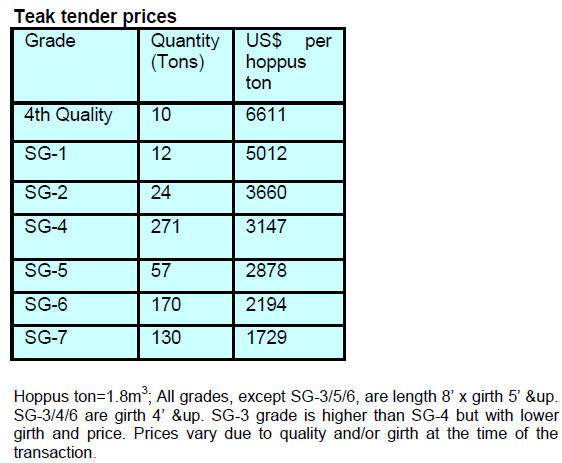
¡¡
6.
INDIA
Second quarter GDP supported by increased
agricultural output
Recently released statistics from the government show that
in the second quarter India¡®s GDP grew 4.8%, up from
4.4% in the first quarter. This compares to the 5.2% in the
second quarter of the last fiscal year.
The improvement in second quarter 2013 GDP, say
analysts, was mainly due to higher agricultural output
which supported rural income growth and overall national
consumption. In addition, the monsoon rains restocked
dams providing for an increase in hydro-power output of
almost 8%.
In recent months exports have grown because of
improvement in demand from the main western markets
and this, coupled with depreciation of the rupee, has
created new export opportunities.
In the domestic market the Wholesale Price Index grew
7% during October and the Consumer Price Index still
hovers in double digits, a cause for considerable concern
on the part of consumers.
Celebrating forests, the annual tree plant festival
Analysts point out that this year the monsoon rains were
evenly distributed and of satisfactory intensity. During the
monsoon period India has a tradition of mass planting of
trees called Van Mahotsav or ‗celebrating forests¡®.
This movement was initiated in 1950 by India's Union
Minister for Agriculture, Kulapati Dr K M Munshi. This
festival has gained immense national importance and
every year, millions of saplings are planted all across India
in observation of the Van Mahotsav week.
It is expected that every citizen of India has to plant a
sapling in the Van Mahotsav week. It helps spread
awareness amongst people about the harm caused by the
cutting down of trees.
People celebrate Van Mahotsava by planting trees or
saplings in homes, offices, schools, colleges, etc.
Awareness campaigns are held at various levels. The State
Governments, NGOs, Village Welfare bodies as well as
private groups enthusiastically plant useful trees. The
Indian Forest Service supplies hundreds of thousands of
saplings for this annual event.
Reports from Karnataka said that many Sandalwood
saplings were supplied along with fruit bearing trees such
as Jambul (Eugenia spp.), Wild Badam (Terminalia
catappa), Kokum (Garcinia spp.), Jackfruit (Artocarpus
integrefolia), wild Jackfruit (Artocarpus hirsute), and
Jaarige (Garcinia spicata) Tamarind, Gooseberry
(Terminalia spp) etc .
The trend is to plant trees yielding high value timbers such
as sandalwood, red-sanders, teak and mahogany as well as
fruits and medicinal products. Planting is made on
wasteland, denuded forest lands, city parks, along roads
and also in plantations. Individuals also plant in their
gardens.
Similar activities were reported from Kerala, where the
Forest Department joined forces with major
establishments such as Southern Railways, the Indian
Army, Navy, Air Force and Student Police Cadets, under
their Harith Keralam or Green Kerala project. It was
reported that the railways alone planted 120,000 saplings.
Indian buyers accepting smaller logs
As the rupee exchange rate has stabilised importers have
more confidence in planning forward purchases. Demand
for wood products in India is steadily picking up and
buyer¡®s specifications are easing to take advantage of the
availability of small girth plantation teak logs which are
available at attractive prices. These changes are reflected
in the log import prices below.
Current C & F prices for imported plantation teak, Indian
ports per cubic metre are shown below.
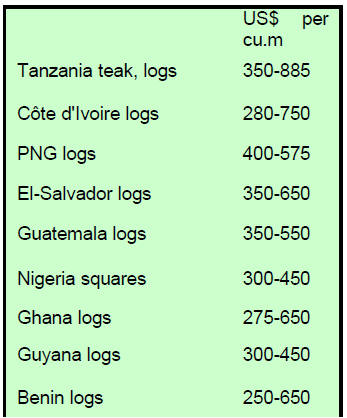
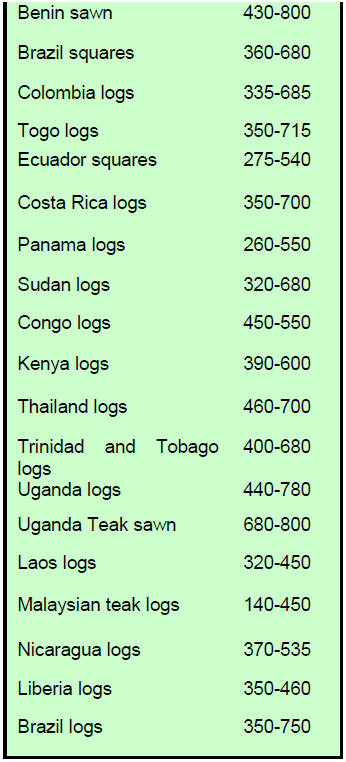
¡¡
Variations are based on quality, lengths of logs
and the average
girth of the logs.
For the first time teak log imports from Cameroon have
been reported at US$ 350 to 510 per cubic metre.
Furniture manufacturers investing in new technologies
Demand for sawnwood in India is steadily improving and
deliveries from South East Asia have expanded. Sarawak
continues to be the largest supplier of tropical hardwoods
to India the number one buyer of logs from Sarawak.
Tropical timbers are popular in the building industry and
are of growing interest to Indian furniture manufacturers.
With IKEA having finalised its investment in India the
furniture sector as a whole has been given a boost and
domestic manufacturers are retooling to become more
competitive. Already some plants have world class
production capacity.
Seeing the opportunities in the furniture industry, Hettich,
one of the leading manufacturers of furniture fittings, has
opened a Rs. 1 billion state-of-the-art production facility in
Gujarat. The company has announced plans for Rs.5
billion, 5 year investment plan for manufacturing in India.
The maturing of furniture industry in India will boost
domestic consumption of wood and wood products and
increased exports will boost earnings by the sector.
Domestic ex-sawmill prices for air dried
sawnwood cut
from imported logs
Prices for air dry sawnwood per cubic Foot, ex-sawmill
are shown below.
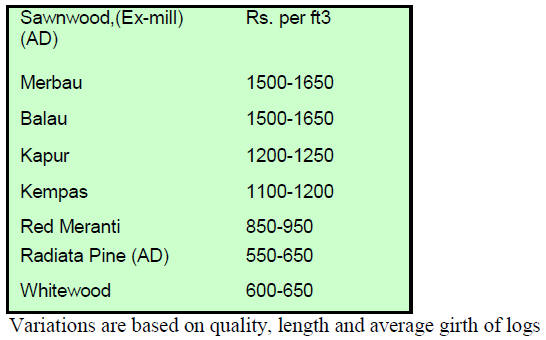
Domestic prices for Myanmar teak processed in
India
Export demand for teak products manufactured in India
continues to be good but domestic demand for Myanmar
teak products is only from selective high net worth clients.
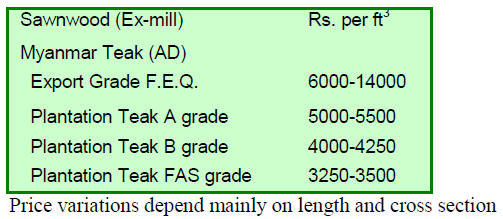
Prices for imported sawnwood
India imported around US$1.83 million worth of
American hardwood lumber and veneers in the first six
months of this year and prices remain very stable.
Ex-warehouse prices for imported kiln dry (12% mc.)
sawnwood per cu.ft are shown below.
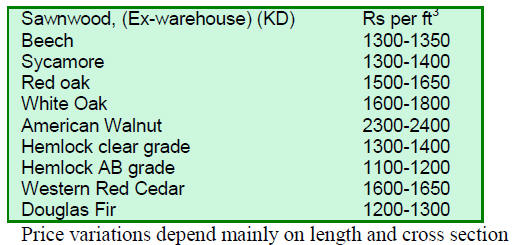
West African exporters begin shipping veneers to
India
The housing sector in India continues to be depressed and
the prospects for any quick turnaround are slim. Analysts
report a shortage of construction grade veneers which is
pushing up imports. In addition to SE Asian countries.
West African countries have also started to supply core
and face veneers from tropical hardwoods to Indian
plywood manufacturers.
Analysts report it is likely that wage rates under
Rural
Employment Guarantee scheme are likely to be raised
which will increase the labour costs and could further
worsen the problem of labour shortages in the wood
working sector.
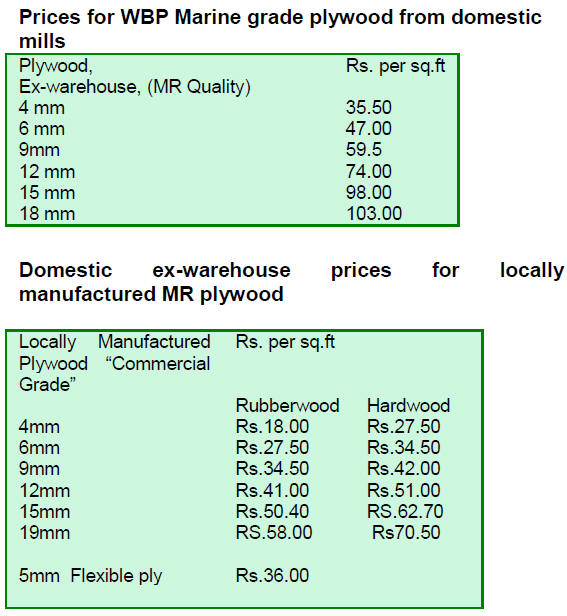
7.
BRAZIL
Brazilian furniture production
slowed in September
Reports indicate that national furniture production fell by
almost 2% in September but for the first three quarters of
2103; there was a 3.2% increase in output compared to the
same period in 2012.
In the state of Rio Grande do Sul during August and
September furniture manufacturers reported a 5.6%
increase in output which equates to the production of some
7.8 million items. However for the first three quarters of
the year output from manufacturers in Rio Grande do Sul
declined 0.4% compared to the same period in 2012.
Furniture retail sales also fell by around 9% in terms of
items sold and by 8% in terms of revenue. However, the
figures for the first three quarters of the year are more
encouraging as retail sales increased 5.5% in number of
items and by 8.6% in terms of value.
Investment in the furniture sector in the first six months of
the year, the latest for which data is available, increased
48%, in comparison with the same period in 2012. The
Brazilian Development Bank (BNDES) disbursed some
US$95 million for investment in the furniture sector up to
July this year.
In other encouraging news, Brazilian imports of wood
working machinery for the furniture sector increased
almost 6% up to October of this year compared to the
same period in 2012.
Rio Grande do Sul state remains furniture export
leader
The state of Rio Grande do Sul remains the leader
amongst Brazilian states exporting furniture with
US$171.5 million being exported between January and
October this year.
The main export destinations for furniture manufactured in
Rio Grande do Sul were the United Kingdom (US$24.8
mil.), Uruguay (US$21.7 mil.) and Peru (US$20 mi.).
Total Brazilian furniture exports between January and
October were US$588.3 mil. and the main market was
Argentina.
According to the Furniture Industries Association of State
of Rio Grande do Sul (Movergs), the state manages to hold
onto its number one position because manufacturers
benefit from a programme to compensate exporters for the
high tax burden and from government incentives.
However, the advantage to exporters is threatened as the
government plans to end the ¨DReintegra¡¬ programme
through which it returns 3% of the value of exports to
exporters.
The states of Santa Catarina and Paran¨¢ are the second and
third ranked in terms of furniture exports with sales of
US$154.7 mil. and US$100.7 mil. up to October this year.
In fourth place is Bahia state where exports this year
fell13% compared to 2012.
The data on exports are reported by Movergs in
collaboration with the Furniture Management Center for
Innovation (CGI Moveleiro) and are based on Ministry of
Development, Industry and Foreign Trade (MDIC) data.
Domestic market absorbing most tropical plywood
The sectoral study undertaken by the Brazilian Association
for Mechanically Processed Timber Industry (ABIMCI)
presents trends in the Brazilian domestic market for
tropical plywood for the period 2000-2012.
Overall, production of tropical plywood, particularly for
export, has declined over the past few years due mainly to
the difficulty in obtaining quality raw materials from
verified legal sources, to the more intense control of
logging and because of intense competition from Chinese
made plywood.
The ABIMCI report says in 2012 tropical plywood
production in Brazil was 483,000 cubic metres, a 51%
decline between 2000 and 2012. Domestic consumption
of tropical plywood in Brazil was 426,000 cubic metres in
2012, representing a 22% increase since 2000.
The trend towards Brazilian production of tropical
plywood for the domestic market and a reduction in
exports is very apparent as, between 2000 and 2012, the
share of tropical plywood production consumed
domestically rose from 35% in 2000 to 88% in 2012.
The peak year for the Brazilian tropical plywood
production was 2004 but by this time China was already a
major plywood exporters with around 18% of the world
market compared to Brazil¡®s 12% share.
In 2012, China continued to dominate the international
tropical plywood markets and increased its overall market
share to just under 37% while Brazil¡®s share of the
international market for tropical plywood declined to
under 5%.
Brazil¡¯s 2000-2012 tropical plywood export trend
The ABIMCI study mentioned above provides details of
trends in Brazil¡®s export of tropical plywood between
2000-2012.
In that period Brazil¡®s tropical plywood exports fell a
massive 91% in volume and 83% in value. In 2000
approximately 64% of the Brazilian tropical plywood
production was exported but by 2012 this had fallen to just
12% with a significant proportion of production being
directed to the domestic market.
Until 2004 tropical plywood exports expanded largely
because of demand in the United States and Europe but in
2005 exports dropped because of an increase in import
taxes in the United States and the depreciation of the
American Dollar against the Brazilian Real. In 2009
exports were severely affected by the global economic
crisis.
Between 2011 and 2012 exports of tropical plywood
declined 22% in volume and 20% in value, declining from
74,500 cubic metres to 58,200 cubic metres (US$45.5
million to US$36.2 million, respectively). Brazil still faces
stiff competition in international markets from Asian
countries such as China, Malaysia and Indonesia which are
major tropical plywood exporters.
Companies in the state of Paran¨¢ provide most of Brazil¡®s
tropical plywood accounting for around 29% of all tropical
plywood exports but the value of these exports has fallen
from US$ 45.4 mil. in 2008 to US$20.5 mil. in 2012. The
state of Santa Catarina is second ranked in terms of
tropical plywood exports.
Manufacturers in the states of Par¨¢, Mato Grosso do Sul
and Acre, once traditional producers of plywood made
entirely of veneer from tropical species, lost market share
between 2008 and 2009. At the same time producers in the
state of Rondônia sold tropical plywood worth US$ 4
million in 2008 and managed to maintain exports in the
region of US$2 mil. in 2012.
In 2008, Brazilian exports of tropical plywood were
mainly to Europe especially the United Kingdom (28%),
Italy (6%), and Germany (5%). The United States
accounted for 14% of the total and Venezuela for 10%. In
2012 the export share changed and the main destinations
became Argentina (35%) and Venezuela (14%).
In 2008 imports by the United States represented 10%
followed by Puerto Rico 7% and Germany 5%.
Price trends
The average price of timber products in BRL did not show
variation from the previous fortnight.
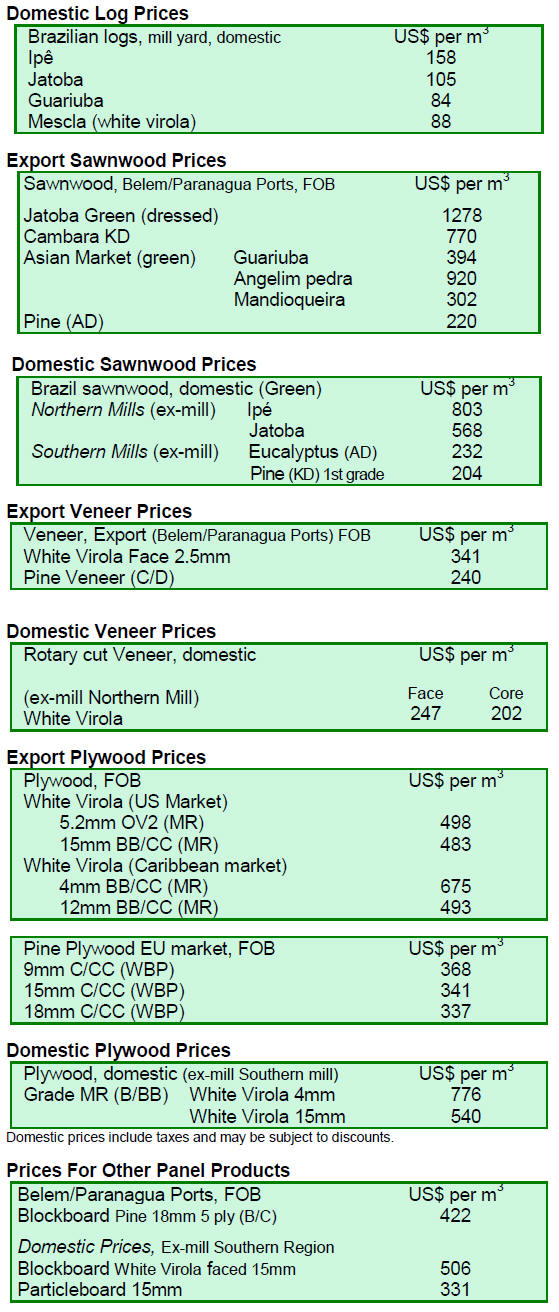

8. PERU
Lack of awareness of environmental issues
partly the
cause of forest loss
Over the past ten years forest loss in Cusco has become a
matter of concern for regional and national authorities as
deforestation rates are affecting the flora and fauna in the
state.
Analysts suggest the main factors driving deforestation in
Cusco are the construction of roads without proper
management and the increase in a population that does not
understand issues related to environmental conservation.
The areas most affected in Cusco are Quillabamba,
Vilcabamba, Kimbiri and Pichari. Deforestation in
Quincemil, in the province of Quispicanchi , is influenced
by illegal mining. The buffer zone of the Manu National
Park has also been affected but here remedial work is
underway.
Environmental issues have become part of the national
agenda and the government and local administrations give
priority to the recovery of deforested areas.
Agrobanco special office opened in Iquitos
Agrobanco the state financial service that supports
development of the forest sector has opened a new office
in Iquitos.
The head of the new office said he will promote forestry
and agricultural development in the Loreto region and has
projected 2014 lending to promote forest industries and
the production of sacha inchi and camu camu .The new
office will have autonomy for the evaluation and approval
of credit applications.
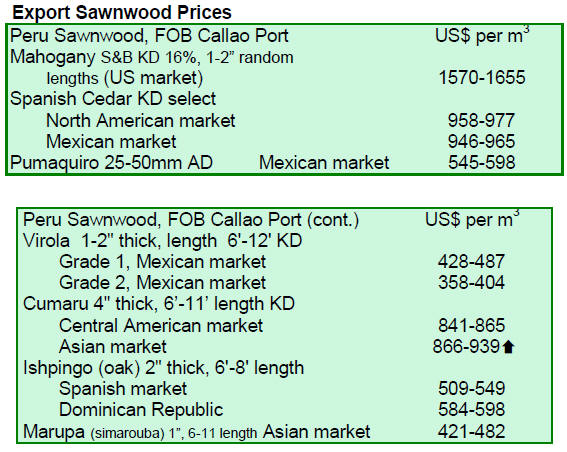
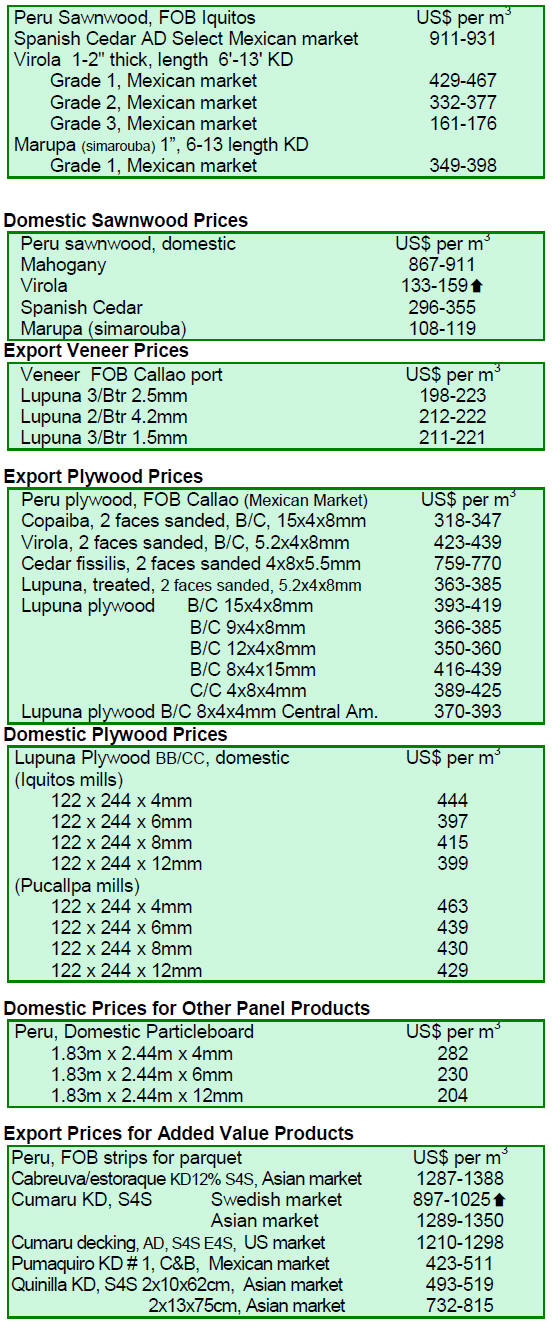
¡¡
9.
GUYANA
International demand for purpleheart logs
sustained
There were no exports of greenheart and mora logs in the
period reviewed but some purpleheart contracts were
shipped.
For current shipments purpleheart attracted FOB export
prices of US$385 per cubic metre for Standard sawmill
quality while the Small sawmill quality logs earned a
positive price of US$240 per cubic metre.
The main destination for Guyana¡®s purpleheart logs
during
the period reviewed was Asia.
Export prices for Undressed sawnwood slip slightly
Sawnwood exports made a positive contribution towards
total export earnings during this period. Undressed
greenheart earned favourable top end prices and Select
category prices were US$1,145 per cubic metre FOB,
down slightly in comparison to the previous period when
at top end price of US$1,484 was secured.
Merchantable category undressed sawn greenheart top end
prices remained stable at US$721 per cubic metre FOB.
The Caribbean and North America were the main market
for this Undressed greenheart sawnwood.
Exports of Undressed purpleheart sawnwood continued
earning favourable prices of US$1,200 per cubic metre
FOB for Prime category while Select category the top end
price fell from US$2,250 to US$1,993 per cubic metre
FOB. The primary markets were the Caribbean, Oceania
(New Zealand) and North America.
Undressed Mora sawnwood attracted fair prices in
international markets in the period reviewed. Select
category earned top end price of US$ 975 per cubic metre
FOB, while for Sound and Merchantable qualities
previous FOB price levels were maintained at around
US$500 per cubic metre. Exporters of mora serviced
demand in the Caribbean, European and North American
markets.
Caribbean markets prefer dressed sawnwood
Exports of Dressed sawnwood were made and earnings
were positive. Shipments of Dressed greenheart earned
FOB prices of US$1,377 per cubic metre as against US$
1,102 per cubic metre in the previous period.
Similarly Dressed purpleheart also made a notable
contribution to overall earnings with an increase top end
price of US$1,187 per cubic metre FOB as against
US$1,060 in the previous period. The Caribbean stood
alone as the major destination for both Dressed greenheart
and purpleheart sawnwood.
Plywood exports resumed and favourable prices in the
region of US$584 per cubic metre FOB were achieved in
the markets of the Caribbean and South America.
Roundwood (greenheart piles) FOB prices moved to as
much as US$565 per cubic metre for Caribbean, European
and North American destinations.
Splitwood (shingles) prices were acceptable at US$1,023
per cubic metre FOB with the Caribbean and North
America as the main markets supporting exports of these
products.
Promoting domestic acceptance of a wider range of
species
One of the functions of the Forest Products Development
and Marketing Council (FPDMC) ¨C in collaboration with
the Guyana Forestry Commission and the Forest Products
Association ¨C is the promotion the utilisation of the lesser
used species of woods (LUS) found in Guyana.
These LUS have properties that are comparable to the
more commercialised species in terms of green density,
heartwood, grain and texture etc. This has been verified
by the UK Timber Research and Development Association
and the Tropenbos International Foundation.
Extensive tests conducted on fifteen species including
Black Kakaralli, Darina, and Fukadi have found that the
properties of these species are similar to the more
commercialised species such as greenheart, purpleheart,
crabwood and locust.
The FPDMC has published a handbook that groups lesser
used species into categories based on their properties. This
information is detailed in a FPDMC¡®s Handbook. A
number of domestic sawmills and lumber yards are now
offering mixed hardwood packages, that is, a greater
number of species to make up a specific order. This
approach seeks to promote greater use of LUS at home
and overseas.
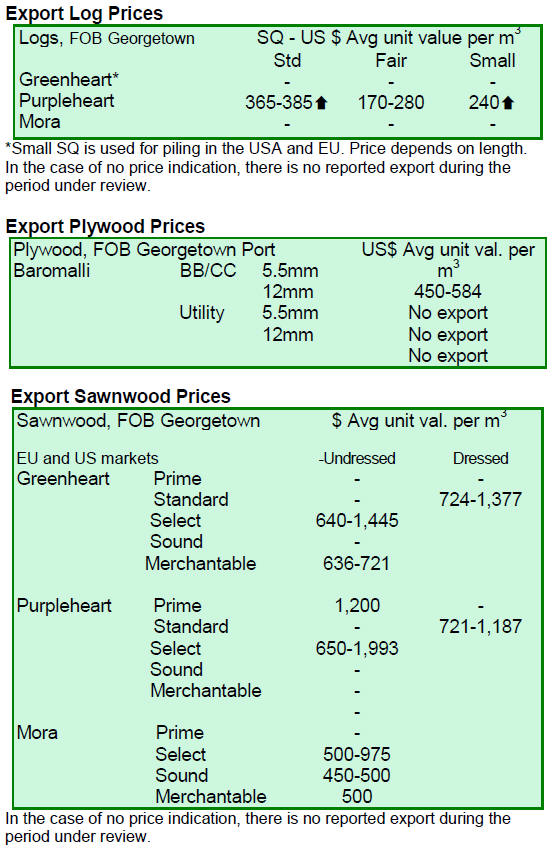
¡¡
